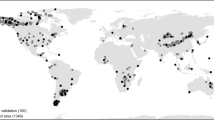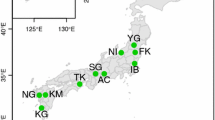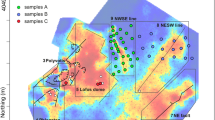Abstract
We present a comparative study of soil CO2 flux (\(F_{{\rm CO}_2 }\)) measured by five groups (Groups 1–5) at the IAVCEI-CCVG Eighth Workshop on Volcanic Gases on Masaya volcano, Nicaragua. Groups 1–5 measured \(F_{{\rm CO}_2 }\) using the accumulation chamber method at 5-m spacing within a 900 m2 grid during a morning (AM) period. These measurements were repeated by Groups 1–3 during an afternoon (PM) period. Measured \(F_{{\rm CO}_2 }\) ranged from 218 to 14,719 g m−2 day−1. The variability of the five measurements made at each grid point ranged from ±5 to 167%. However, the arithmetic means of fluxes measured over the entire grid and associated total CO2 emission rate estimates varied between groups by only ±22%. All three groups that made PM measurements reported an 8–19% increase in total emissions over the AM results. Based on a comparison of measurements made during AM and PM times, we argue that this change is due in large part to natural temporal variability of gas flow, rather than to measurement error. In order to estimate the mean and associated CO2 emission rate of one data set and to map the spatial \(F_{{\rm CO}_2 }\) distribution, we compared six geostatistical methods: arithmetic and minimum variance unbiased estimator means of uninterpolated data, and arithmetic means of data interpolated by the multiquadric radial basis function, ordinary kriging, multi-Gaussian kriging, and sequential Gaussian simulation methods. While the total CO2 emission rates estimated using the different techniques only varied by ±4.4%, the \(F_{{\rm CO}_2 }\) maps showed important differences. We suggest that the sequential Gaussian simulation method yields the most realistic representation of the spatial distribution of \(F_{{\rm CO}_2 }\), but a variety of geostatistical methods are appropriate to estimate the total CO2 emission rate from a study area, which is a primary goal in volcano monitoring research.










Similar content being viewed by others
References
Bergfeld D, Goff F, Janik CJ (2001) Elevated carbon dioxide flux at the Dixie Valley geothermal field, Nevada; relations between surface phenomena and the geothermal reservoir. Chem Geol 177:43–66
Burton M, Oppenheimer C, Horrocks L, Francis P (2000) Remote sensing of CO2 and H2O emission rates from Masaya volcano, Nicaragua. Geology 28:915–918
Carapezza ML, Granieri D (2004) CO2 soil flux at Vulcano (Italy): comparison of active and passive methods. Appl Geochem 19:73–88
Cardellini C, Chiodini G, Frondini F (2003) Application of stochastic simulation to CO2 flux from soil: mapping and quantification of gas release. J Geophys Res 108:2425
Chiodini G, Cioni GR, Guidi M, Raco B, Marini L (1998) Soil CO2 flux measurements in volcanic and geothermal areas. Appl Geochem 13:543–552
Chiodini G, Cardellini C, Frondini F, Granieri D, Marini L, Ventura G (2001) CO2 degassing and energy release at Solfatara Volcano, Campi Flegrei, Italy. J Geophys Res 106:16213–16221
Delmelle P, Stix J, Baxter P, Garcia-Alvarez J, Barquero J (2002) Atmospheric dispersion, environmental effects and potential health hazard associated with the low-altitude gas plume of Masaya volcano, Nicaragua. Bull Volcanol 64:423–434
Delmelle P et al (1999) Origin, effects of Masaya volcano’s continued unrest probed in Nicaragua. Eos (Transactions, American Geophysical Union) 80:575,581
Deutsch CV, Journel AG (1998) GSLIB, geostatistical software library and users guide. Oxford Univ Press, New York
Duffell H, Oppenheimer C, Burton M (2001) Volcanic gas emission rates measured by solar occulation spectroscopy. Geophys Res Lett 28:3131–3134
Evans WC, Sorey ML, Kennedy BM, Stonestrom DA, Rogie JD, Shuster DL (2001) High CO2 emissions through porous media: transport mechanisms and implications for flux measurement and fractionation. Chem Geol 177:15–29
Farrar CD, Sorey ML, Evans WC, Howle JF, Kerr BD, Kennedy BM, King Y, Southon JR (1995) Forest-killing diffuse CO2 emission at Mammoth Mountain as a sign of magmatic unrest. Nature 376:675–678
Finney DJ (1941) On the distribution of a variate whose logorithm is normally distributed. J Royal Statis Soc Suppl 7:144–161
Fornberg B, Driscoll TA, Wright G, Charles R (2002) Observations on the behavior of radial basis function approximations near boundaries. Comp Math Appl 43:473–490
Gerlach T, Doukas M, McGee K, Kessler R (2001) Soil efflux and total emission rates of magmatic CO2 at the Horseshoe Lake tree kill, Mammoth Mountain, California. Chem Geol 177:101–116
Giammanco S, Gurrieri S, Valenza M (1997) Soil CO2 degassing along tectonic structures on Mount Etna (Sicily); the Pernicana fault. Appl Geochem 12:429–436
Gilbert RO (1987) Statistical methods for environmental pollution monitoring. Van Nostrand Reinhold, New York
Goovaerts P (2001) Geostatistical modeling of uncertainty in soil science. Geoderma 103:3–26
Hardy RL (1971) Multiquadric equations of topography and other irregular surfaces. J Geophys Res 76:1905–1915
Horrocks L, Burton M, Francis P (1999) Stable gas plume composition measured by OP-FTIR spectroscopy at Masaya Volcano, Nicaragua, 1998–1999. Geophys Res Lett 26:3497–3500
Isaaks EH, Srivastava RM (1989) An introduction to applied geostatistics. Oxford University Press, New York
Lewicki JL, Connor C, St-Amand K, Stix J, Spinner W (2003a) Self- potential, soil CO2 flux, and temperature on Masaya volcano, Nicaragua. Geophys Res Lett 30:1817
Lewicki JL, Evans WC, Hilley GE, Sorey ML, Rogie JD, Brantley SL (2003b) Shallow soil CO2 flow along the San Andreas and Calaveras faults, CA. J Geophys Res 108:2187
Pérez N, Salazar J, Saballos A, Álvarez J, Segura F, Hernández P, Notsu K (2000) Diffuse degassing of CO2 from Masaya caldera, Central America. Eos Trans AGU, Fall Meet Suppl
Rogie JD, Kerrick DM, Sorey ML, Chiodini G, Galloway DL (2001) Dynamics of carbon dioxide emission at Mammoth Mountain, California. Earth Planet Sci Lett 188:535–541
Saito H, Goovaerts P (2000) Geostatistical interpolation of positively skewed and censored data in a dioxin-contaminated site. Environ Sci Technol 34:4228–4235
Salazar JM, Hernández PA, Pérez NM, Melián G, Alvarez J, Segura F, Notsu K (2001) Diffuse emission of carbon dioxide from Cerro Negro volcano, Nicaragua, Central America. Geophys Res Lett 28:4275–4278
Shapiro SS, Wilk MB (1965) An analysis of variance test for normality (complete samples). Biometrika 52:591–611
Sichel HS (1952) New methods in the statistical evaluation of mine sampling. London Inst Mining Met Trans 61:261–288
St-Amand K (1999) The distribution and origin of radon, CO2, and SO2 gases and multifractal behavior of SO2 at Masaya volcano, Nicaragua. Master’s thesis, Université de Montréal
Stoiber RE, Williams SN, Huebert BJ (1986) Sulfur and halogen gases at Masaya caldera complex, Nicaragua: total flux and variations with time. J Geophys Res 91:12215–12231
Wardell LJ, Delmelle P, Fischer T, Lewicki JL, Malavassi E, Stix J, Strauch W (2003) Volcanic gas workshop fosters international focus on state of the art measurement techniques. Eos (Transactions, American Geophysical Union) 84(47):519
Watson DF (1992) Contouring: a guide to the display and analysis of spatial data. Pergamon, New York
Welles JM, Demetriades-Shah TH, McDermitt DK (2001) Considerations for measuring ground CO2 effluxes with chambers. Chem Geol 177:3–13
Werner CA, Brantley SL, Boomer K (2000) CO2 emissions related to the Yellowstone volcanic system 2: statistical sampling, total degassing, and transport mechanisms. J Geophys Res 105:10831–10846
Acknowledgements
J. Lewicki was supported by the U.S. Department of Energy under Contract No. DE-AC03-76SF00098 and NASA grant NA-11318 (University of South Florida). C. Werner was supported by the GeoNet Project sponsored by the following New Zealand governmental agencies: Earthquake Commission (EQC), Geological and Nuclear Sciences Limited (GNS), and Foundation for Research, Science and Technology (FRST). D. Bergfeld was supported by the U.S. Geological Survey as a National Research Council Post-Doctoral Associate. N. Varley received funding from the Universidad de Colima (FRABA 169/03). We acknowledge the Eighth Field Workshop on Volcanic Gases, sponsored by the Commission on the Chemistry of Volcanic Gases and the International Association of Volcanology and Chemistry of the Earth’s Interior for the opportunity to make comparative soil CO2 flux measurements on Masaya volcano. We are grateful to G.E. Hilley for insightful discussions and H. Shinohara, W.C. Evans, D. Thomas, P. Hsieh, and C. Doughty for constructive reviews
Author information
Authors and Affiliations
Corresponding author
Additional information
Editorial responsibility: H Shinohara
Appendices
Appendix I: Data Analyses
MVU Estimators
The mean of the lognormal distribution was estimated using the MVU estimator \(\hat \mu\) according to
where \(\bar y\) is the arithmetic mean of the n log-transformed values y i , calculated according to
and \(s_y^2\) is the variance of the n transformed values, calculated according to
(e.g., Gilbert 1987). The variance of the lognormal distribution was estimated using the MVU estimator \(\hat \sigma\) according to
RB
The RB estimator \(\hat z(u)\) computes the value z at unsampled location u (a vector of spatial coordinates) as a weighted linear combination of multiquadric radial basis functions associated with surrounding observations:
where n is the number of sampled points in the data set,
is a basis function of the distance on the x-y plane between u and u i modified by the arbitrary nonnegative constant e, and w i is the weight assigned to each basis function (e.g., Watson 1992). The weights are found through the solution of a system of linear equations:
and
where μ is the Lagrange parameter to satisfy the condition that the weights sum to zero (Eq. (9)).
OK
OK estimates the value \(\hat z(u)\) at unsampled location u (a vector of spatial coordinates) as a weighted linear combination of surrounding observations:
where n is the number of sampled points in the data set, z(u i ) is the value of the sampled point, and w i is the weight assigned to each sampled point (e.g., Isaaks and Srivastava 1989). The weights are found through the solution of a system of linear equations:
and
where γ(u i −u j ) is the semivariogram model evaluated at the distance between points i and j and μ is the Lagrange parameter. Constraining the weights to sum to unity (Eq. (12) ) maintains the unbiasedness of the estimator. The spherical semivariogram model equation is
where s, a, and n are the sill, range, and nugget effect, respectively, each determined from the statistical properties of the sampled data (e.g., Isaaks and Srivastava 1989). Additionally, the semivariogram can be used to calculate the estimation variance σ 2(u) as
Appendix II: Recommendations for Accumulation Chamber \(F_{{\rm CO}_2 }\) Measurements in Volcanic-Hydrothermal Environments
-
1.
The IRGA should be calibrated with standard gases prior to \(F_{{\rm CO}_2 }\) measurement, according to the suggestions of the IRGA manufacturer.
-
2.
Water must be removed from the accumulation chamber air using an in-line desiccant (e.g., Mg(ClO4)2 or molecular sieve) before the air enters the IRGA.
-
3.
Soil disturbance should be minimized during placement of the accumulation chamber on the soil surface to create a measurement footprint. A horizontally flat area should also be selected if possible. If necessary (e.g., an uneven soil surface is present), the researcher should create all measurement footprints within the survey area in a given order, and then return to the footprints to make the \(F_{{\rm CO}_2 }\) measurements in the same order. This protocol should allow ample time for re-equilibration of gas flow following initial soil disturbance.
-
4.
When the chamber is placed on the soil for \(F_{{\rm CO}_2 }\) measurement, a seal must be obtained between the accumulation chamber and the soil to prevent chamber-atmosphere gas exchange.
-
5.
Once the [CO2]–t curve is obtained, the researcher should select the linear segment of the curve, the slope of which is used to calculate \(F_{{\rm CO}_2 }\). The period of data collection must be sufficient to allow for adequate mixing of the atmospheric gas with the soil gas. The amount of time required for this to occur varies with \(F_{{\rm CO}_2 }\). Short-term (a few seconds or less) changes in the [CO2]–t curve should be ignored.
-
6.
After a \(F_{{\rm CO}_2 }\) measurement has been completed, the accumulation chamber measurement system should be flushed with atmospheric air before commencing a new measurement.
-
7.
Soil temperature should be measured in conjunction with each \(F_{{\rm CO}_2 }\) measurement.
-
8.
The \(F_{{\rm CO}_2 }\) survey should be conducted under meteorologically stable conditions. In particular, \(F_{{\rm CO}_2 }\) measurements should not be made during and immediately following periods of rainfall.
-
9.
To obtain datasets suitable for consistent geostatistical treatment, \(F_{{\rm CO}_2 }\) measurements should be homogeneously distributed throughout the survey area (e.g., along measurement grids). Spatial clustering of measurements should be avoided when possible. Moreover, \(F_{{\rm CO}_2 }\) measurements should be made in both areas of anomalously high \(F_{{\rm CO}_2 }\) and background areas lacking CO2 emissions of deep volcanic-hydrothermal origin.
Rights and permissions
About this article
Cite this article
Lewicki, J.L., Bergfeld, D., Cardellini, C. et al. Comparative soil CO2 flux measurements and geostatistical estimation methods on Masaya volcano, Nicaragua. Bull Volcanol 68, 76–90 (2005). https://doi.org/10.1007/s00445-005-0423-9
Received:
Accepted:
Published:
Issue Date:
DOI: https://doi.org/10.1007/s00445-005-0423-9




